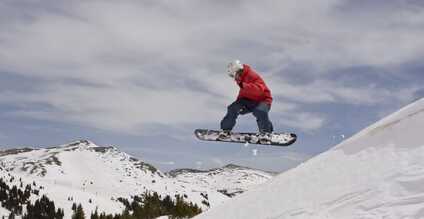|
Tricia Hayton, Registered Physiotherapist  It has happened - the first snowfall of the year. In my house, it is always an event filled with excitement and promise. Promise of hitting the slopes in the days (okay, months) to come. For me, that means tuning the skis and endless reps of squats and twists to prep the quads. But my boys are snowboarders, how does their prep differ from mine? How do they prep for the slopes to keep up with their Mom? The number one difference is the calves. Working the toe edge of your board can really take a toll on your calves. Calf raises are a great way to work the muscle in your calf. Standing on one foot, slowly raise up onto your toe and lower. For a little extra work, hold onto a 10- to 20-pound dumbbell. To get a little bit of bonus balance work, stand on a foam pad or boscu ball while doing the exercise. Obliques are working a little harder as well. I am not saying that skiers don’t need to work those twisting muscles, but the demands are higher in boarding. I am currently a big fan of the standing twist exercise as muscles are very position specific and generally, we are trying to avoid laying on our backs on the hills. For this exercise, you will need a partner. Grab a medicine ball that is the right weight for you, stand in a slight squat position on the “ball” side of the boscu ball. Have your partner stand behind you, twist to one side and hand the ball to your partner. Twist fully to the other direction and grab the ball from your partner. Keep going for 30 reps. Make sure to repeat the exercise to the other side. Of course, there is one big similarity. Quads! Boarders need to be doing their squats and lunges too. Adding a jump squat is a great way to improve performance on the jumps or in the parks. How do you prep for the season? Let us know by commenting below. See you on the slopes!
0 Comments
Your comment will be posted after it is approved.
Leave a Reply. |
Physio Sport Med
Serving all of Oakville in the Uptown / Dundas-Trafalgar Core. Archives
May 2025
Categories |
- Info
- Book Now
-
Team
-
How We Treat
- Sport Medicine Consultation
- Manual - Exercise Physio
- Sport Physiotherapy
- Tissue Injections
- Acupuncture
- Vestibular Physiotherapy
- Osteopathy
- Chiropractic Care
- Concussion Program
- Shockwave Therapy
- Female Pelvic Health
- Male Pelvic Health
- Registered Massage Therapy
- Nutrition Consultation
- On-Field Therapy Coverage
- Custom Orthotics
-
What We Treat
- Sports Injuries
- Low Back Pain
- Osteoarthritis
- Motor Vehicle Accident
- Sprains
- Muscle Strains
- Concussion
- Rotator Cuff
- Tendonitis
- Neck Pain and Headaches
- Hip Pain
- Shoulder Pain
- Elbow, Wrist and Hand Pain
- Foot and Ankle Pain
- Post Surgical Rehabilitation
- Gait and Balance Disorders
- Knee Injuries
- Pelvic Floor Conditions
- Blog

 RSS Feed
RSS Feed